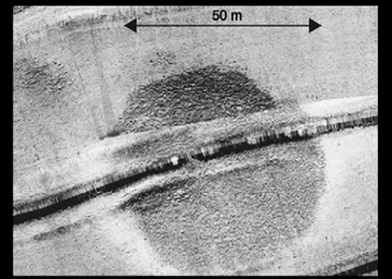Discovery in the Sea of Galilee
Here’s an interesting find: a huge mountain made of uncut stones purposely created thousands of years ago and is now submerged in the Sea of Galilee. What’s the meaning of the mount? Truth is, nobody knows, but it seems to have some cultic meaning which would suggest that the area of the Sea of Galilee was an important religious center thousands of years before the preacher from Galilee.
Excerpts from article in huffingtonpost.com
A giant “monumental” stone structure discovered beneath the waters of the Sea of Galilee in Israel has archaeologists puzzled as to its purpose and even how long ago it was built.
The mysterious structure is cone shaped, made of “unhewn basalt cobbles and boulders,” and weighs an estimated 60,000 tons the researchers said. That makes it heavier than most modern-day warships.
Rising nearly 32 feet (10 meters) high, it has a diameter of about 230 feet (70 meters). To put that in perspective, the outer stone circle of Stonehenge has a diameter just half that with its tallest stones not reaching that height.
It appears to be a giant cairn, rocks piled on top of each other. Structures like this are known from elsewhere in the world and are sometimes used to mark burials. Researchers do not know if the newly discovered structure was used for this purpose.
The structure was first detected in the summer of 2003 during a sonar survey of the southwest portion of the sea. Divers have since been down to investigate, they write in the latest issue of the International Journal of Nautical Archaeology.
“Close inspection by scuba diving revealed that the structure is made of basalt boulders up to 1 m (3.2 feet) long with no apparent construction pattern,” the researchers write in their journal article. “The boulders have natural faces with no signs of cutting or chiselling. Similarly, we did not find any sign of arrangement or walls that delineate this structure.”
Researcher Yitzhak Paz, of the Israel Antiquities Authority and Ben-Gurion University, believes it could date back more than 4,000 years. “The more logical possibility is that it belongs to the third millennium B.C., because there are other megalithic phenomena [from that time] that are found close by,” Paz told LiveScience in an interview, noting that those sites are associated with fortified settlements.


